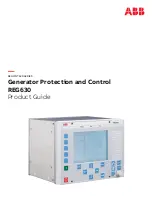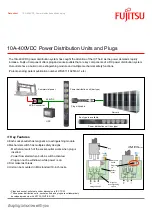
Manual MRG3
SEG Electronics GmbH
DOK-TD-MRG3, Rev. D
65
6.4.6 Checking of the pick-up and release values for over/under frequency
Note!
Due to frequency changes, vector surge tripping or df/dt - tripping can occur during frequency tests.
In order to ensure a trouble-free test procedure, the vector surge function or df/dt function of the re-
lay have to be blocked before tests are started.
During frequency tests, each of the frequency elements should be tested separately. This makes it
necessary that the other frequency elements of the relay have to be blocked by setting the fre-
quency pickup values
f
1
- f
3
to "EXIT". For testing the pickup and dropout to pickup values, the test frequency has to be
increased (decreased) until the relay is energized. This is indicated by lighting up of LEDs f + 1 +
<(>), f + 2 + <(>) or f + 3 + <(>).
When comparing the values displayed with those of the frequency meter, the deviation must not
exceed 0.01 Hz. The dropout to pickup values are ascertained by increasing (decreasing) the test
frequency slowly until the output relay releases.
The dropout to pickup value for over frequency must be >0.99, and for under frequency <1.01.
6.4.7 Checking of the tripping delay time for over/under frequency s
The tripping delay of the over/under frequency functions can be tested in the similar manner as in
chapter 6.4.6 for over/under voltage functions.
6.4.8 Checking of the vector surge function
Note!
With the help of an advanced relay test equipment a phase shift (vector surge) on the voltage sig-
nal can be obtained to test the vector surge function of MRG3 re-lay. If there is no such testing fa-
cility available, a very simple simulation circuit may be used to test the vector surge function of the
relay with a sufficient accuracy. Figure 6.2 shows the possibility to simulate a phase shift by means
of a RC circuit. Closing or opening the switch S1 causes the phase angle of the input voltage to
change depending on the adjustable resistance R.
The phase angle obtained may be calculated with the following formula and is almost independent
on the test voltages.
In case of a 3-phase vector surge, the angle
can be calculated with the following formula if the
parameters R0, R and C are known:
= arctg
1
𝑅
0
𝜔∙𝐶
− 𝑎𝑟𝑐𝑡𝑔
1
(𝑅
0
+𝑅)𝜔∙𝐶
Example: R0 = 1 Ohm, R = 363 Ohm, C = 3 µF
then:
19°
Usually the voltage source impedance R
0
is negligible, hence R
0
may be assumed zero. Thus, the
value of R may be calculated using the following simplified formula:
= 90° - arctg
1
𝑅∙𝜔∙𝐶
Note!
Using the above test circuit with single-phase vector surge, the resulting measured phase angle
is about half the value of
calculated for a 3-phase vector surge.
To make tripping possible during a one phase test procedure, the vector surge tripping has to be
set to "1Ph".
















































